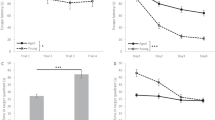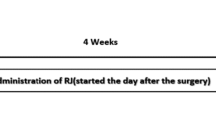Abstract
In the present study, the effect of inosine was evaluated on learning and memory of 18 months old aged female rats. Inosine (50, 100 and 200 mg/kg; i.p.) was administered to separate groups of rats for 15 successive days. Donepezil (1 mg/kg; i.p.), an acetylcholinesterase inhibitor, was used as a standard drug. Behavioral models such as Morris water maze and elevated plus maze were used to evaluate the effect of drugs on learning and memory of rats. After behavioral studies, animals were killed and their brain was isolated and further processed for estimation of various biochemical parameters such as acetylcholinesterase activity, oxidative stress markers, proinflammatory marker and histological examinations. Inosine (100 and 200 mg/kg) significantly improved learning and memory of aged rats. Further, inosine significantly reduced lipid peroxidation and nitrite, and increased the levels of reduced glutathione and superoxide dismutase. However, no significant difference in AChEs activity was observed in inosine-treated rats as compared to aged control rats. TNF-α level was found to be ameliorated in aged rats by inosine. Histopathological evaluation showed that inosine-treated aged rats have less number of pyknotic neurons in hippocampal CA1 region as compared to aged control rats. In conclusion, inosine significantly improved learning and memory of aged female rats possibly through its antioxidant as well as anti-inflammatory effect and improvement of neuronal survival in the hippocampal CA1 region. However, additional studies are required to further explore the downstream signaling pathways involved in the neuroprotective effect of inosine in aged animals.









Similar content being viewed by others
Abbreviations
- AChE:
-
Acetylcholinesterase
- AD:
-
Alzheimer’s disease
- ANOVA:
-
Analysis of variance
- CPCSEA:
-
Committee for the Purpose of Control and Supervision of Experiments on Animals
- DTNB:
-
5,5′ dithio-bis-2-nitro benzoic acid
- EL:
-
Escape latency
- GSH:
-
Reduced glutathione
- ITL:
-
Initial transfer latency
- LPO:
-
Lipid peroxidation
- MDA:
-
Malondialdehyde
- NO:
-
Nitric oxide
- RTL:
-
Retention transfer latency
- SOD:
-
Superoxide dismutase
- TL:
-
Transfer latency
- TSTQ:
-
Time spent in target quadrant
- WHO:
-
World Health Organization
References
Alzheimer’s Association (2017) Alzheimer’s disease facts and figures. Alzheimer’s Dementia 13:325–373
Barja G (2002) Rate of generation of oxidative stress-related damage and animal longevity. Free Radic Biol Med 33:1167–1172
Barrientos RM, Kitt MM, Watkins LR, Maier SF (2015) Neuroinflammation in the normal aging hippocampus. Neurosci 309:84–99
Benowitz LI, Goldberg DE, Irwin N (2002) Inosine stimulates axon growth in vitro and in the adult CNS. Prog Brain Res 137:389–399
Blasko I, Stampfer-Kountchev M, Robatscher P, Veerhuis R, Eikelenboom P, Grubeck-Loebenstein B (2004) How chronic inflammation can affect the brain and support the development of Alzheimer’s disease in old age: the role of microglia and astrocytes. Aging Cell 3:169–176
Campuzano O, Castillo-Ruiz MM, Acarin L, Castellano B, Gonzalez B (2009) Increased levels of proinflammatory cytokines in the aged rat brain attenuate injury-induced cytokine response after excitotoxic damage. J Neurosci Res 87:2484–2497
Casolini P, Catalani A, Zuena AR, Angelucci L (2002) Inhibition of COX-2 reduces the age-dependent increase of hippocampal inflammatory markers, corticosterone secretion, and behavioral impairments in the rat. J Neurosci Res 68:337–343
Chen P, Goldberg DE, Kolb B, Lanser M, Benowitz LI (2002) Inosine induces axonal rewiring and improves behavioral outcome after stroke. Proc Natl Acad Sci USA 99:9031–9036
Chung HY, Sung B, Jung KJ, Zou Y, Yu BP (2006) The molecular inflammatory process in aging. Antioxid Redox Signal 8:572–581
Cipriani S, Bakshi R, Schwarzschild MA (2014) Protection by inosine in a cellular model of Parkinson’s disease. Neurosci 274:242–249
Dachir S, Shabashov D, Trembovler V, Alexandrovich AG, Benowitz LI, Shohami E (2014) Inosine improves functional recovery after experimental traumatic brain injury. Brain Res 25:78–88
Das A, Dikshit M, Nath C (2001) Profile of acetylcholinesterase in brain areas of male and female rats of adult and old age. Life Sci 68:1545–1555
David JP et al (1997) Glial reaction in the hippocampal formation is highly correlated with aging in human brain. Neurosci Lett 235:53–56
Dhull DK, Jindal A, Dhull RK, Aggarwal S, Bhateja D, Padi SS (2012) Neuroprotective effect of cyclooxygenase inhibitors in ICV-STZ induced sporadic Alzheimer’s disease in rats. J Mol Neurosci 46:223–235
Ellman GL (1959) Tissue sulfhydryl groups. Arch Biochem Biophys 82:70–77
Ellman GL, Courtney KD, Andres V Jr, Feather-Stone RM (1961) A new and rapid colorimetric determination of acetylcholinesterase activity. Biochem Pharmacol 7:88–95
Freeman LR, Keller JN (2012) Oxidative stress and cerebral endothelial cells: regulation of the blood-brain-barrier and antioxidant based interventions. Biochim Biophys Acta 5:822–829
Fukui K, Onodera K, Shinkai T, Suzuki S, Urano S (2001) Impairment of learning and memory in rats caused by oxidative stress and aging, and changes in antioxidative defense system. Ann N Y Acad Sci 928:168–175
Gibbs RB (2000) Long-term treatment with estrogen and progesterone enhances acquisition of a spatial memory task by ovariectomized aged rats. Neurobiol Aging 21:107–116
Gordon P (1974) US Patent, Publication No. US3857940 A
Gornall AG, Bardawill CJ, David MM (1949) Determination of serum proteins by means of the biuret reaction. J Biol Chem 177:751–766
Green LC, Wagner DA, Glogowski J, Skipper PL, Wishnok JS, Tannenbaum SR (1982) Analysis of nitrate, nitrite, and [15N]nitrate in biological fluids. Anal Biochem 126:131–138
Gudkov SV, Shtarkman IN, Smirnova VS, Chernikov AV, Bruskov VI (2006) Guanosine and inosine display antioxidant activity, protect DNA in vitro from oxidative damage induced by reactive oxygen species, and serve as radioprotectors in mice. Radiat Res 165:538–545
Gülinnaz Alper EYS, Kanit Lütfiye, Mentes Gülriz, Ersoz Biltan, Kutay Fatma Z (1998) Age-related alterations in superoxide dismutase and catalase activities in rat brain. Trop J Medical Sci 29:491–494
Harburger LL, Bennett JC, Frick KM (2007) Effects of estrogen and progesterone on spatial memory consolidation in aged females. Neurobiol Aging 28:602–610
Hasko G, Sitkovsky MV, Szabo C (2004) Immunomodulatory and neuroprotective effects of inosine. Trends Pharmacol Sci 25:152–157
Hou B, Xu ZW, Yang CW, Gao Y, Zhao SF, Zhang CG (2007) Protective effects of inosine on mice subjected to lethal total-body ionizing irradiation. J Radiat Res 48:57–62
Kaster MP, Budni J, Gazal M, Cunha MP, Santos AR, Rodrigues AL (2013) The antidepressant-like effect of inosine in the FST is associated with both adenosine A1 and A 2A receptors. Purinergic Signal 9:481–486
Kim HG, Lee JS, Choi MK, Han JM, Son CG (2014) Ethanolic extract of Astragali radix and Salviae radix prohibits oxidative brain injury by psycho-emotional stress in whisker removal rat model. PLoS ONE 9:e98329
Kono Y (1978) Generation of superoxide radical during autoxidation of hydroxylamine and an assay for superoxide dismutase. Arch Biochem Biophys 186:189–195
Kulkarni SK, Dhir A (2008) On the mechanism of antidepressant-like action of berberine chloride. European J Pharmacol 589:163–172
Kumar A, Prakash A, Pahwa D, Mishra J (2012) Montelukast potentiates the protective effect of rofecoxib against kainic acid-induced cognitive dysfunction in rats. Pharmacol Biochem Behav 103:43–52
Kumar A, Ekavali Mishra J, Chopra K, Dhull DK (2016) Possible role of P-glycoprotein in the neuroprotective mechanism of berberine in intracerebroventricular streptozotocin-induced cognitive dysfunction. Psychopharmacol 233:137–152
Lee CK, Weindruch R, Prolla TA (2000) Gene-expression profile of the ageing brain in mice. Nat Genet 25:294–297
Ljubuncic P, Gochman E, Reznick AZ (2010) Nitrosative stress in aging—its importance and Biological implications in NF-κB signaling. In: Bondy S, Maiese K (eds) Aging and age-related disorders. Humana Press, Totowa, pp 27–54
Lombardi VR, Garcia M, Rey L, Cacabelos R (1999) Characterization of cytokine production, screening of lymphocyte subset patterns and in vitro apoptosis in healthy and Alzheimer’s Disease individuals. J Neuroimmunol 97:163–171
Lopez-Otin C, Blasco MA, Partridge L, Serrano M, Kroemer G (2013) The hallmarks of aging. Cell 153:1194–1217
Lourbopoulos A, Erturk A, Hellal F (2015) Microglia in action: how aging and injury can change the brain’s guardians. Front Cell Neurosci 9
Lull ME, Block ML (2010) Microglial activation and chronic neurodegeneration. Neurotherapeutics 7:354–365
Markowitz CE, Spitsin S, Zimmerman V, Jacobs D, Udupa JK, Hooper DC, Koprowski H (2009) The treatment of multiple sclerosis with inosine. J Altern Complement Med 15:619–625
Maruyama W, Kato Y, Yamamoto T, Oh-Hashi K, Hashizume Y, Naoi M (2001) Peroxynitrite induces neuronal cell death in aging and age-associated disorders: a review. J Am Aging Assoc 24:11–18
Morel GR, Andersen T, Pardo J, Zuccolilli GO, Cambiaggi VL, Herenu CB, Goya RG (2015) Cognitive impairment and morphological changes in the dorsal hippocampus of very old female rats. Neurosci 303:189–199
Morris R (1984) Developments of a water-maze procedure for studying spatial learning in the rat. J Neurosci Methods 11:47–60
Perry EK et al (1992) Convergent cholinergic activities in aging and Alzheimer’s disease. Neurobiol Aging 13:393–400
Radak Z, Zhao Z, Goto S, Koltai E (2011) Age-associated neurodegeneration and oxidative damage to lipids, proteins and DNA. Mol Aspects Med 32:305–315
Sandstrom NJ, Kim JH, Wasserman MA (2006) Testosterone modulates performance on a spatial working memory task in male rats. Horm Behav 50(1):18–26
Sharma AC, Kulkarni SK (1992) Evaluation of learning and memory mechanisms employing elevated plus-maze in rats and mice. Prog Neuropsychopharmacol Biol Psychiatry 16:117–125
Sierra A, Gottfried-Blackmore AC, McEwen BS, Bulloch K (2007) Microglia derived from aging mice exhibit an altered inflammatory profile. Glia 55:412–424
Singh KKS, Kumari K, Singh G, Kaur A (2009) Alterations in lipid peroxidation and certain antioxidant enzymes in different age groups under physiological conditions. J Hum Ecol 27:143–147
Smith JM et al (2007) Inosine promotes recovery of skilled motor function in a model of focal brain injury. Brain 130:915–925
Sonkusare S, Srinivasan K, Kaul C, Ramarao P (2005) Effect of donepezil and lercanidipine on memory impairment induced by intracerebroventricular streptozotocin in rats. Life Sci 77:1–14
Spangenberg EE et al (2016) Eliminating microglia in Alzheimer’s mice prevents neuronal loss without modulating amyloid-beta pathology. Brain 139:1265–1281
Starling RD, Trappe TA, Short KR, Sheffield-Moore M, Jozsi AC, Fink WJ, Costill DL (1996) Effect of inosine supplementation on aerobic and anaerobic cycling performance. Med Sci Sports Exerc 28:1193–1198
Sultana R, Perluigi M, Butterfield DA (2006) Protein oxidation and lipid peroxidation in brain of subjects with Alzheimer’s disease: insights into mechanism of neurodegeneration from redox proteomics. Antioxid Redox Signal 8:2021–2037
Udeochu JC, Shea JM, Villeda SA (2016) Microglia communication: parallels between aging and Alzheimer’s disease. Clin Exp Neuroimmunol 7:114–125
Uttara B, Singh AV, Zamboni P, Mahajan RT (2009) Oxidative stress and neurodegenerative diseases: a review of upstream and downstream antioxidant therapeutic options. Curr Neuropharmacol 7:65–74
van Groen T, Kadish I, Wyss JM (2002) Old rats remember old tricks; memories of the water maze persist for 12 months. Behav Brain Res 136:247–255
Warner HR (1994) Superoxide dismutase, aging, and degenerative disease. Free Radic Biol Med 17:249–258
WHO, Dementia (2017) http://www.who.int/mediacentre/factsheets/fs362/en/. Accessed 13 Dec 2017
Wills ED (1966) Mechanisms of lipid peroxide formation in animal tissues. Biochem J 99:667–676
Wu H, Zhao J, Chen M, Wang H, Yao Q, Fan J, Zhang M (2017) The anti-aging effect of erythropoietin via the ERK/Nrf2-ARE pathway in aging rats. J Mol Neurosci 61:449–458
Ye SM, Johnson RW (1999) Increased interleukin-6 expression by microglia from brain of aged mice. J Neuroimmunol 93:139–148
Acknowledgements
This research did not receive any specific grant from funding agencies in the public, commercial, or not-for-profit sectors. The authors would like to thank the Honorable Vice-Chancellor, Guru Jambheshwar University of Science and Technology for providing financial support and infrastructural facilities to carry out this work.
Author information
Authors and Affiliations
Contributions
DD conceptualized the project; PR planned and performed the experiments (animal behavioral study, biochemical estimations, ELISAs, histology); DD and PR analyzed all the data and wrote the manuscript. Authors critically reviewed the manuscript and approved for final submission.
Corresponding author
Ethics declarations
Conflict of interest
There is no conflict of interest among authors.
Rights and permissions
About this article
Cite this article
Ruhal, P., Dhingra, D. Inosine improves cognitive function and decreases aging-induced oxidative stress and neuroinflammation in aged female rats. Inflammopharmacol 26, 1317–1329 (2018). https://doi.org/10.1007/s10787-018-0476-y
Received:
Accepted:
Published:
Issue Date:
DOI: https://doi.org/10.1007/s10787-018-0476-y




